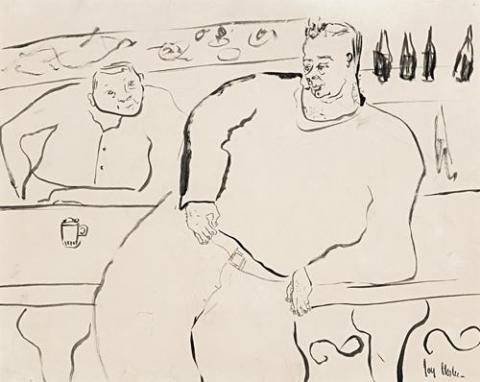AT THE BAR, c.1944
Joy Hester
brush and ink on paper
40.5 x 50.5 cm
signed lower right with artist's estate stamp
The Reed Family Collection, Victoria
'Joy Hester has contributed a highly personal, original vision to Australian art. The most distinctive aspect of her artistic output is evident in her focused concentration on the human head and face as a source of feeling and psychological insight. She recognised intuitively that the smallest details have the capacity to alter the mood of a work and was able to compress a depth and intensity of emotion into specific features with a few precise strokes of brush or ink. Her work entwines a profound intimacy of connection emanating from her life experiences, with a feeling for the complexities of what it is to be human. The poet Barrett Reid, one of Hester's close contemporaries, described her drawings as black and white stills - which simultaneously reveal shared aspects of human suffering and love - from a film drama that she lived.
Like other artists working in Melbourne in the forties, such as Albert Tucker, Sidney Nolan, John Perceval and Arthur Boyd, Hester's formative work is inseparable from the context of the Depression and Second World War. She was very much part of her times - involved in friendships and debates with artists, writers and poets who were concerned about the fate of humanity and who championed the cause of modern art' Compared with the works of her peers however, Hester's art is elemental. It is neither narrative nor mythological but pares away extraneous details to reach the essence of states of mind, being and emotional resonance. In her capacity to focus her vision - to encompass psychological complexity with a minimum of means '...she understood the dynamic links between drawing and poetic distillation.'1
1. Hart, D., 'A Personal Vision: The War Years' in Joy Hester and Friends, National Gallery of Australia, Canberra, 2001, pp. 9-10
